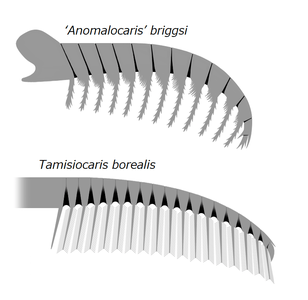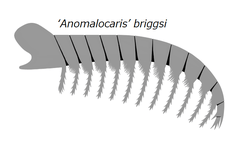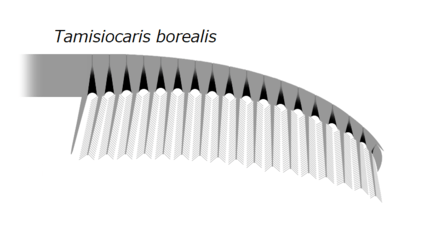Cetiocaridae
Cetiocaridae (meaning "whale shrimp") is a clade of radiodont, an extinct stem-group arthropods. The group was named after the Bearded Ceticaris (Cetimimus barbus)[1] in the speculative paleoart book All Your Yesterdays by John Meszaros.[2] In later studies the group was renamed as a radiodont family Tamisiocarididae.[3][4]
| Cetiocaridae | |
|---|---|
 | |
| Frontal appendages of Anomalocaris briggsi and Tamisiocaris borealis | |
| Scientific classification | |
| Kingdom: | Animalia |
| Phylum: | Arthropoda |
| Class: | †Dinocaridida |
| Order: | †Radiodonta |
| Suborder: | †Anomalocarida |
| Clade: | †Cetiocaridae Vinther et al., 2014 |
Description
Like most radiodonts, cetiocarids have spiny frontal appendages, but in this family the auxiliary spines are fine and densely-arranged, which are modified for use in filter feeding like modern basking sharks and mysticete whales. For example, Tamisocaris is estimated to have fed on prey roughly a millimeter in size.[5]
Classification
| |||||||||||||||||||||||||||||||||
| Phylogenetic relationships of Tamisiocarididae[5] |
Tamisiocarididae was originally named Cetiocaridae. In the 2013 speculative paleoart book All Your Yesterdays, paleoartist John Meszaros depicted a hypothetical filter-feeding anomalocaridid he named "Ceticaris". This artwork inspired the name of Cetiocaridae.[5] However, as no genus "Cetiocaris" actually exists, the name Cetiocaridae does not comply with article 29 of the International Code of Zoological Nomenclature and is invalid.[6] The family Tamisiocarididae was subsequently devised as a replacement name for the clade.[7] Cetiocaridae was originally defined phylogenetically as all species more closely related to Tamisiocaris borealis than to Anomalocaris canadensis, Amplectobelua symbrachiata, or Hurdia victoria.[5]
| Species | Describers | Year Named | Age | Location | Frontal Appendage |
|---|---|---|---|---|---|
| Anomalocaris briggsi | Nedin | 1995 | Cambrian Stage 4 |  | |
| Tamisiocaris borealis | Daley & Peel | 2010 | Cambrian Stage 3 |  | |
Distribution
Tamisocaridid fossils have been found in the Emu Bay Shale of Australia, Sirius Passet lagerstätte of Greenland, and Kinzers Formation of the United States.[7] Their fossils date to stage 3 and stage 4 of the Cambrian.
External Links
References
- "Bearded Ceticaris by NocturnalSea on DeviantArt". www.deviantart.com. Retrieved 2020-02-18.
- Kosemen CM (2013). All Your Yesterdays. Irregular Books. p. 74.
- Lerosey-Aubril R, Pates S (September 2018). "New suspension-feeding radiodont suggests evolution of microplanktivory in Cambrian macronekton". Nature Communications. 9 (1): 3774. doi:10.1038/s41467-018-06229-7. PMC 6138677. PMID 30218075.
- Pates S, Daley AC, Butterfield NJ (2019-06-11). "First report of paired ventral endites in a hurdiid radiodont". Zoological Letters. 5 (1): 18. doi:10.1186/s40851-019-0132-4. PMC 6560863. PMID 31210962.
- Vinther J, Stein M, Longrich NR, Harper DA (March 2014). "A suspension-feeding anomalocarid from the Early Cambrian" (PDF). Nature. 507 (7493): 496–9. doi:10.1038/nature13010. PMID 24670770.
- Van Roy, Peter; Daley, Allison C.; Briggs, Derek E. G. (2015). "Anomalocaridid trunk limb homology revealed by a giant filter-feeder with paired flaps". Nature. 522 (7554): 77–80. doi:10.1038/nature14256.
- Pates, Stephen; Daley, Allison C. (2019). "The Kinzers Formation (Pennsylvania, USA): the most diverse assemblage of Cambrian Stage 4 radiodonts". Geological Magazine. 156 (07): 1233–1246. doi:10.1017/S0016756818000547.